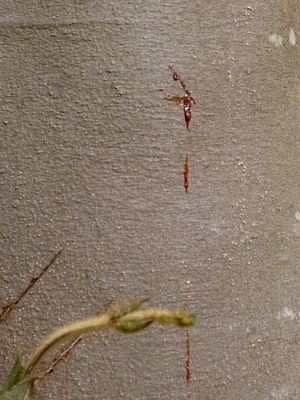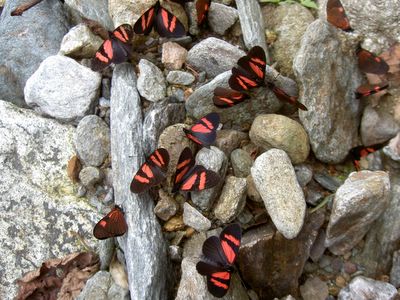Diane: After breakfast, our guide, Linder, showed us a Dragon's Blood tree. I had been offered this medicine in the markets of Cuenca, but I had no idea it came from a tree.
When Linder scratched the surface bark of the tree, a blood-colored sap oozed out.
When he rubbed the sap on his had, it turned a beigish color. Linder explained that when used this way, it helped stop bleeding and reduce scarring associated with a wound. I believe it is currently undergoing trials in the U.S.
The horses we used yesterday were not available today. Their owner had ridden from San Miguel de Cuyes to meet us yesterday and then walked with us back to his home.
We actually passed several of his homes. As I talk to more people, it becomes obvious that the lack of a road here creates a different way of thinking about property and home ownership. Most families have one house "in town" where they can buy and sell goods and another near their farm or where they graze their animals. Many have more depending on the work they do. This is a poor area, so owning so many houses is not really a measure of wealth, but rather a necessity. Yesterday as we drove the road from Jima, we passed a volunteer work crew composed of local farmers - men, women, and children, old and young. They were using shovels to level the torn-up road and create better drainage. As a group, they maintained a house near the road, so they would have a place to stay while doing road work.
Linder found a mule to carry our gear.
The mule's owner lived near the next town along the trail. Linder seems to know most everyone we pass along the way. Even so and even though almost everyone in this region keeps horses, there were none available for us. The kids would have to walk today.
Once on the trail, we passed by many cultivated areas as well as areas cleared for grazing. Generally, one or two large trees were left standing in these fields. Each tree maintained its small world of epiphytes, mosses, and lichen.

One such tree was so full of bomeliads, aft first I thought the tree was blooming.
As we walked, we learned more and more about Linder and his relationship to the area. As we crossed the river into Ganazhuma, the next tiny town along the way, Linder explained that he had attended 1st and 2nd grade in this town. The town held a small store, a building with Biblioteca (Libary) painted in large letters that held no books, a health center, a concrete soccer/basketball court, and a church. Linder explained that it had taken 114 mules to cart in the concrete mix needed for the soccer court. Luckily the town is adjacent to the river, and therefore, sand was readily available. Soccer is certainly a passion in Ecuador no matter how small the town.
Once outside of Ganazhuma, the number of butterflies increased dramatically. Large and small, they flitted about their business. They also gathered in groups, evidently when they found something good to eat or drink.
As we got closer to the orchid farm, Linder started talking about what to expect there. If there was no moon, we had a good chance of seeing lots of butterflies once it got dark. Just before we headed down the steep trail from the main path to the farm, he mentioned that his Dad was already there with his cows, but would be leaving for Jima in the morning. Linder was an orchid expert and this was his (family's) orchid farm!
The kitchen was in the old house. Linder's father had built a stove out of a large flat rock plastered with mud. You burn wood underneath it and cook on top of it. This was the first night Linder cooked for us and he made a wonderful banana soup from green bananas his father picked from the trees outside.
Although we are sleeping on the floor again, I did get to take a cold shower and after a long day's walk, I hope to sleep a bit.
TM: So, an amazing trip from the Andes to the Jungle. It was beyond anything I have ever done, and not only the scenery. I saw people who live in a completely different world than any I have ever seen. No power. No running water. No roads. The only way in and out by a horse trail, with the nearest power source being a day’s journey away. Living in the middle of a jungle. Almost everyone has a horse, mule or donkey. Many of the people living out in the wilderness are raising cattle, either for meat or milk, but mostly for the latter. Apparently, a lot of the people who are out there actually lived in the city, but felt like they were doing nothing of any use, so returned to the mountains to work.
A problem that has really damaged the economic stability of these towns is migration. People go to the US(almost solely illegally and, from Ecuador, to New York) where they get a terrible apartment where between 6 and 8 people live together, allowing for a low rent of around 200 dollars per person, monthly. Often they get a job in construction and another at night working in a Quick-E-Mart type store. They can usually get between $3000 and $5000 a month. They then send a sizable portion of that back to their families here, who instead of putting that money into the community with business or services, build themselves needlessly large houses and don’t end up doing any work at all. This leaves the people who don’t have relatives in the US in the worst possible state of poverty. Thus, the population of towns, especially those that are out of the way, has dwindled over the years. Some have a population made up of almost entirely women and children.
We stopped at one little town (if you could even call it that) and I bought a coke. While I was sitting in front of the shop drinking it, a little boy and little girl, neither of whom could have been more than five years old, started to walk up. They moved very, very slowly, and when they got about 20 feet away, they stopped. They looked scared out of their wits. Our guide told us then that parents tell their kids that white people will come take them away if they aren’t good. He also told us that we looked like doctors (who come to give vaccinations) and it was possible that they thought we were going to give them shots. Which they were afraid of, because shots hurt.
Anyway, they play Carnaval in the mountains as well, but apparently the main emphasis of the festivities is roasting lots and lots of meats. Beef, pork, sheep, rabbit, cuy (which is Guinea Pig, a delicacy here) and it goes on for three days, just like in the city.
Some other interesting facts which I learned on this trip:
1) Ecuador is the most corrupt country in the entire world.
2) Ecuador is tied for the country with the most abuse of women in the world.
Whoda thunk?

No comments:
Post a Comment